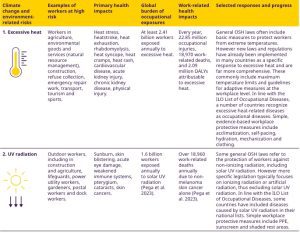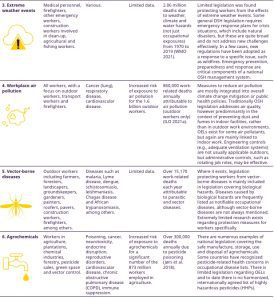
Ensuring safety and health at work in a changing climate: Global Report
Executive Summary
Climate change is already having serious impacts on the safety and health of workers in all regions of the world. Workers are among those most exposed to climate change hazards yet frequently have no choice but to continue working, even if conditions are dangerous. Global occupational safety and health (OSH) protections have struggled to keep up with the evolving risks from climate change, resulting in worker mortality and morbidity.
Collaborative efforts are needed to develop and implement effective mitigation and adaptation measures to protect workers across the globe. The International Labour Organization (ILO) has adopted more than 40 standards specifically related to OSH, which provide policy solutions for dealing with the effects of climate change on communities, workers and enterprises. Furthermore, the Guidelines for a Just Transition towards Environmentally Sustainable Economies and Societies for All (ILO 2015) can help to promote a safe and healthy working environment by supporting workers and employers throughout the transition to a low-carbon economy.
In June 2023, the International Labour Conference urged constituents to implement OSH measures for all workers impacted by climate-related risks and extreme weather events and asked the ILO to consider convening a tripartite meeting on OSH in extreme weather events and changing weather patterns. This report presents critical evidence related to six key impacts of climate change on OSH, which were chosen for their severity and the magnitude of their effects on workers: excessive heat, solar ultraviolet (UV) radiation, extreme weather events, workplace air pollution, vector-borne diseases and agrochemicals.
Key takeaways from the report:
- Billions of workers are exposed to hazards exacerbated by climate change.
- Workers across different sectors are exposed to these hazards but some workers, such as agricultural workers and other outdoor workers carrying out heavy labour in hot climates, may be particularly at risk.
- Strong evidence demonstrates that numerous health conditions in workers have been linked to climate change, including cancer, cardiovascular disease, respiratory illnesses, kidney dysfunction and mental health conditions, among many others.
- Every year, an estimated 22.85 million occupational injuries, 18,970 deaths and 2.09 million disability-adjusted life years (DALYs) are attributable to excessive heat alone. Thousands more die from pesticide poisoning (>300,000), workplace air pollution (>860,000), solar UV radiation (>18,960 due to non-melanoma skin cancer alone) and parasitic and vector-borne diseases (>15,170) (Jørs et al. 2018; ILO 2021a; Pega et al. 2023).
- Many countries have implemented new laws to specifically address excessive heat in the working environment. These primarily include maximum temperature limits and guidelines for adaptive measures at the workplace level. For other climate change impacts, protections for workers are mainly integrated into existing OSH or environmental regulations.
- The content of legislation varies considerably between countries, but may include medical surveillance, occupational disease lists, occupational exposure limits (OELs), training and information, risk assessment and workplace preventive measures.
- As climate change hazards evolve and intensify, it will be necessary to re-evaluate existing legislation or create new regulations and guidance. Some worker populations may be especially vulnerable to the effects of climate change and could therefore need extra protections.
- Social dialogue between governments and social partners is essential for ensuring policies are practical and effective at the workplace level.
- OSH policies and programmes should be coordinated among government departments to ensure policy coherence. For example, it may be beneficial to integrate OSH initiatives into public health campaigns.
- In addition to adapting to the climate change impacts outlined in this report, workplaces can contribute to climate mitigation strategies using measures such as improving energy efficiency.
- The scientific evidence base regarding climate change and OSH is limited in many critical areas. Further research is needed to guide policymaking and other responses. Knowledge transfer is also necessary to educate stakeholders.
- Rapid shifts to green and sustainable technologies may create new OSH challenges, especially if appropriate OSH protections have not been implemented. For example, solar panels, compact fluorescent lamps and lithium-ion batteries contain toxic chemicals which are hazardous to worker health.


